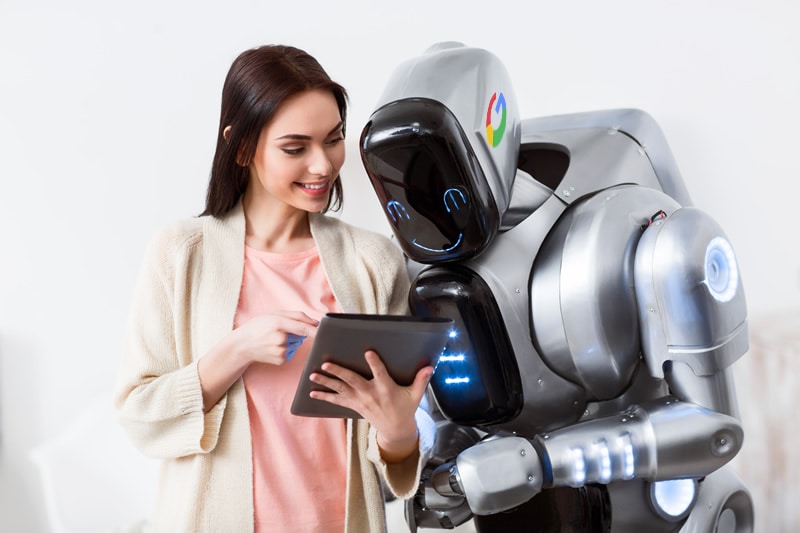When thinking about the rise of machine learning as it relates to SEO, we can be faced with a frightening scenario, depending on the type of SEO professional you are.
SEO pros, like myself, who are logic-based and have historically worked relying on an understanding of the signals at play and how they fluctuate may be chewing their nails more than the marketers who have relied more on serving the users rather than the engines.
Where I once used to scratch my head wondering how the “build great content and they will come” approach was even conceivable, those who subscribe that SEO approach are the ones who are likely less worried today.
And they should be.
Sort of.
It’s still not:
Before we dive into what’s changing let’s first answer the question:
What Is Machine Learning as It Relates to SEO?
We won’t get into a big lesson around all that is machine learning here and we won’t have time to actually cover how it impacts us and what our future SEO strategy needs to look like.
From a 30,000-foot view, all we really need to know is that it adds to Google’s capabilities an incredible speed of:
- Data accumulation.
- Interpretation.
- Reaction.
For more on this, check out my post: How Machine Learning in Search Works: Everything You Need to Know.
And if you really want to know what machine learning is, Google offers a free crash course here.
How Machine Learning Impacts Links & Link Building
One of the easiest examples of an area machine learning can greatly increase Google’s capabilities is in links.
Looking at a small example, machine learning can play a role in one of the key aspects of link evaluation: filtering spam.
Google is already using machine learning in Gmail, reaching a 99.9 percent success rate and only yielding a false-positive 0.05 percent of the time.
Carry this over to link evaluations and you’ve got a very successful model.
Previously, Google engineers would have to:
- Create lists of poor quality sites and block their link equity flow manually.
- Program specific characteristics of a bad link based on what they’d seen prior.
- Set up devaluation functions into link calculations and hope that it didn’t include too many false positives.
With machine learning, the world opens up.
Yes, there is still a primary starting point – a list of known bad domains and another of presumed bad signals.
But these are training grounds a machine learning system can use to:
- Learn how to apply these signals to other links they encounter.
- Develop their own signals for what appears to be spam (or good for that matter).
Rather than simply relying on this hard-and-fast set of criteria, the machines can teach themselves by watching patterns.
Observing sites with presumed-bad signals (in either their linking-out or linking-in) will profile the machine.
Then, once the determination of bad is confirmed, it can start reverse engineering patterns for faster detection in the future.
- What type of sites do spam sites link to?
- What types of links do spam sites get?
- Is there a link growth pattern?
- Do pages that sell paid links also tend to link to other specific sites (they do) and if so which sites?
The system can then add those to the metrics it applies.
This is really touching on less than the tip of an iceberg on how machines can simulate what humans can do and amplify it.
Want to know how Google could announce they are devaluing sites with spam links as opposed to manually penalizing them?
It’s made possible by machines that can learn and apply devaluations at incredible speeds with far lesser false-positives.
Add to that, machines can also understand the content quality and relevancy of a page and supplement that understanding into the equation both individually and en masse.
A machine that can ask, “Should this link hold a high weight for your individual site?” and then further, “Is there a high likelihood that the link is paid or otherwise problematic?” in the context of data from other links found and analyzed on that page and domain.
These are extremely limited examples of where machine learning can be applied to links.
Spam patterns are, and will be, detected with an increasing degree of success, while quality links will be understood and rewarded at a higher rate.
This means an increased focus on quality, relevancy, and legitimacy – unless you feel that you can come up with systems to fool Google faster than a machine can figure it out.
How Machine Learning Impacts Content SEO
While we used the example of links above, there are few other areas of SEO that will be impacted more by the rise of machine learning than content.
To illustrate this point, we need only look at Google’s work in translation.
For 10 years they worked on the problem using phrase-based machine translation – mainly matching known phrases and spewing out a result.
We all remember the results. It got the job done, but was incredibly crude.
In September 2016, they switched to a machine-learning system (Google Neural Machine Translation system) and in the 24 hours after it was rolled out, the system had improved translation more than in the decade prior.
Basically, machine learning can accomplish an efficiency in understanding language more in 24 hours than human editing, even with machine assistance, can in 3,650 times that.
What does this mean for SEO professionals?
The holy grail of digital marketing is coming – that time when our only job will be to put out the best content that we can and a breadth of content wide enough and in enough formats that it satisfies more user intents and preferences than the next one. And if these are completed, there’s a very good chance Google will understand this as well.
This isn’t to say that machines aren’t flawed or that there won’t be a role for SEO professionals.
In fact, I think there will be a larger role for us to play, but it won’t be in keyword use – it will be in formulating how the user can be satisfied.
Wil Reynolds gave one of the best summaries of what I believe is to come. He suggests we ask ourselves:
“What would happen if Google improved to just showing the best answer?”
This is the question we need to ask.
What makes this more interesting is that what is “best” is subjective.
I personally hate video instructions for how to accomplish most tasks – just give me a list with some pictures if necessary.
But not everyone is like that. Some want video and some might prefer a PDF download they can print out.
On top of that, it would be task dependent. For example, I hardly want my tablet under the car with me as I change the oil so a printout is probably better there.
So, what I will consider “best” in regards to a result Google might give depends on a whole array of factors related to my own personal preferences – the specific task I’m trying to accomplish, when and where I am, the type of device I’m on, etc.
This can’t be programmed by a human.
Some decent attempts have been made toward personalized results in the past but they were limited – until machine learning.
A human can’t tailor an experience for you.
Humans can’t dedicate the resources to understanding what you specifically like at specific times, based on what device you’re accessing or where you might be.
Machines can.
A machine can keep track of all that and learn over time not just what results you like but what types of results fulfill your intent and eventually pull the best result for you from their current index.
In short, we now need to think less about fulfilling global rules and more about fulfilling the intent of our targeted audience.
On top of that, if we want to rank for more generic terms like ‘laptops’ and not just ‘buy dell laptops’ with our ecommerce site, we need to fulfill the intents of the users who aren’t just interested in buying one to fulfill the intents of all those visitors. Perhaps, we should also provide that data in various formats so we are the winning answer regardless of the device.
Prior to machine learning, we didn’t have to worry about this. Any attempts at understanding what a bounce or time on site might mean on Google’s side were rudimentary, to say the least.
Now, with machine learning assisting in understanding language context and what user-generated signals might mean this is not just possible but deployed.
Subscribe for Daily Search Insights
AI, PPC, and digital marketing news distilled to fuel success. Join the other 75k marketers!
Think about a great video you’ve produced to address a common question your target demographic has.
Now imagine your target audience is asking their question on a Google Home or other voice-first device. You may not need to provide content in every possible format as your audience may not request it, but you need to be aware.
How Machine Learning Impacts Technical SEO
When it comes to technical SEO, there is one person you need to follow right now: Cindy Krum. Pay attention to what she has to say because she’s on the right track.
In a conversation on mobile-first indexing, she coined a term that I personally believe sums up the future of technical SEO brilliantly. She referred to “mobile-first” as an incorrect term naming the proper one to be “portable-first”.
The idea she put forth was that content should be easily separated from your design and technical structure (i.e., portable) so that it can be accessed anywhere at any time.
She is exactly right.
As we head into this brave new world of machine learning, the goal is to give the user the information that will fulfill their intent.
Our job is to make sure that content can be easily understood and extracted from the construct it exists in – either via markup, XML feeds, or just structuring the content on a page in a manner that is clear and easily interpreted.
So What Do You Do Now?
What should you do with this information?
We’re talking about machine learning and Google’s ever-increasing capability to understand the world around us, as well as our own personal needs and wants. This is its power and this is what defines what we all need to do next.
While I would be remiss to tell anyone to cast away their SEO efforts based on the tried-and-true metrics that still seem to work well, those metrics are evolving and eroding rapidly. I don’t see them surviving for more than two or three years.
Your task is this:
Make sure that your content is portable to whatever device it may be accessed from by your target demographic and that it speaks to that audience.
If you have multiple audiences with multiple needs, you must also ensure that either your content applies and appeals to all of them or that there is different content for each and potentially in different formats.
As an SEO professional in a machine learning world, you need to view keywords more for the question and intent that they imply rather than as a blunt instrument to include on a page and in anchor text.
Machines will help us understand what our visitors want so we can figure out ways to provide it.
Why?
Because that’s what the machine will be looking for – a satisfied user. They’ll have all the metrics they need to know whether you – or one of your competitors – is doing the best job in delivering one.
Image Credits
Featured Image: Paulo Bobita
Field Of Dreams Photo: Adobe Stock
Robots With Plug: Adobe Stock
Robot Reading Tablet Photo: Adobe Stock





